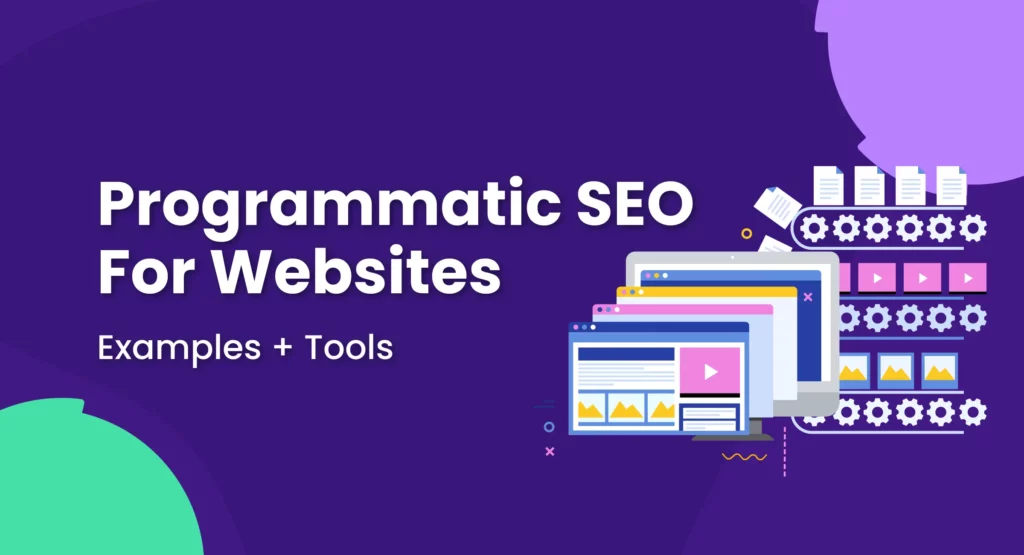
Imagine a world where search engine optimization is no longer a time-consuming, repetitive process. With the right tools, optimizing your website for search engines on a massive scale with just a few clicks is possible. That’s the promise of programmatic SEO, and it can be a solid choice if you’re running a large website.
If you’re an SEO and feel like you’ve mastered the basics, programmatic SEO might still seem intimidating. But I’ll break it down for you so it can be part of your toolbox.
I’ll start by explaining what programmatic SEO is and how it differs from traditional SEO. Then, I’ll explore the advantages and potential risks of using programmatic SEO so that you can weigh the pros and cons for your specific situation. Finally, I’ll give you a short guide to implementing a programmatic SEO strategy, so you can start optimizing websites at scale.
What Is Programmatic SEO?
Programmatic SEO, also known as pSEO, is a technique that involves creating a large number of landing pages to rank on SERPs. To start, you design a landing template with a pre-set layout, images, pricing, and reviews. Then, you’ll use automated tools to create variations of the same page, each targeting a different low-competition keyword.
Your goal is to rank high in the SERPs in a fast, scalable way. You’ll leverage databases, templates, and automation to create thousands of landing pages with identical layouts but unique content.
Here’s an overview from Lazarina’s Stoy’s “What is Programmatic SEO?” lesson inside TTT Academy.
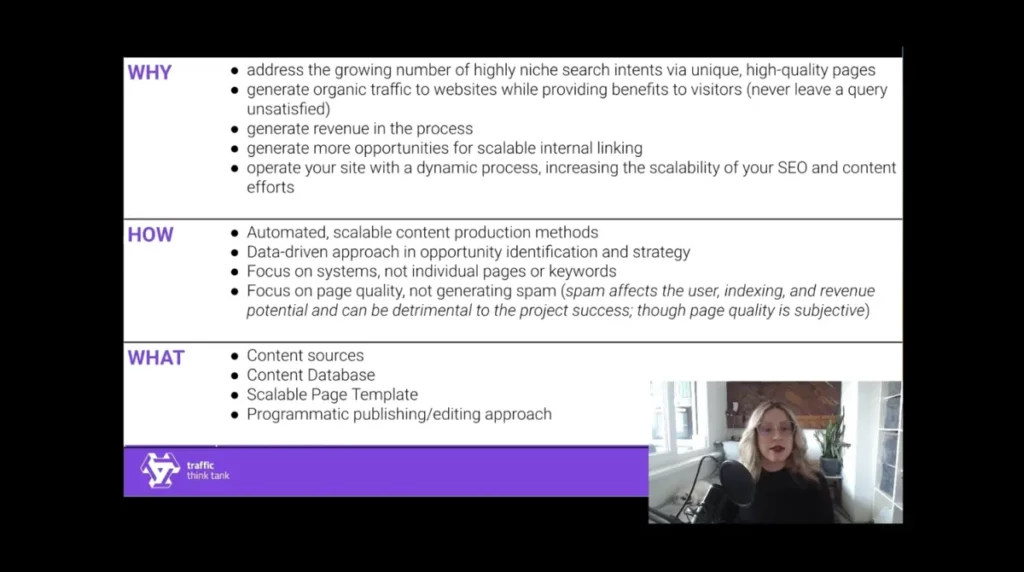
This process is particularly useful for large websites with thousands or millions of pages, such as e-commerce platforms, news sites, or online directories. By automating repetitive tasks, you can save time, reduce human error, and improve your search engine rankings more efficiently.
So, how is programmatic SEO different from the traditional SEO strategies you already use?
Traditional SEO focuses on optimizing individual pages for specific keywords, which can be time-consuming and labor-intensive.
You’re already familiar with this approach: You create unique, high-quality content for each page, build backlinks, and manually adjust on-page elements like titles, meta descriptions, and header tags. Typically, you do all this work manually (perhaps with the help of some link-building tools or keyword research platforms).
In contrast, programmatic SEO relies heavily on automation and templating to create and optimize pages at scale. Instead of crafting each page manually, with programmatic SEO, you use a predefined template and automatically generate content by pulling data from a database or API. You can create hundreds or even thousands of pages targeting a specific long-tail keyword.
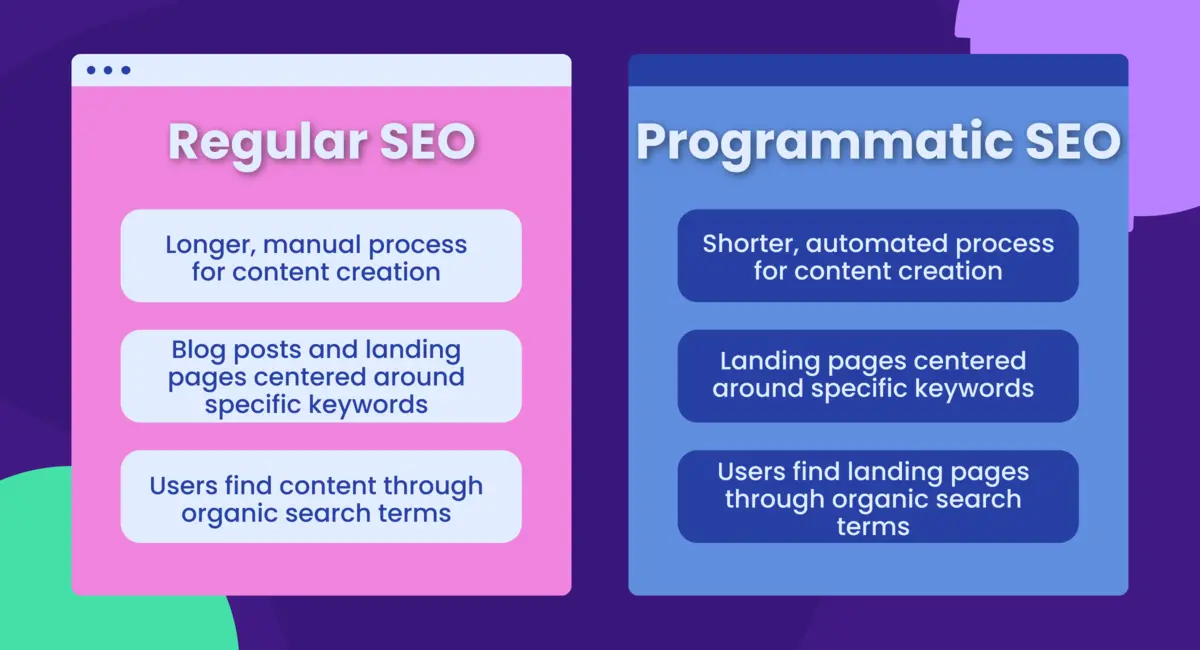
While traditional SEO is better suited for targeting high-competition, short-tail keywords and building a strong overall brand presence, programmatic SEO excels at capturing long-tail search traffic and serving highly specific user intent.
Remember that programmatic SEO should not be viewed as a replacement for traditional SEO. It’s a complementary approach. You can often combine both techniques for large sites, using programmatic SEO to capture long-tail traffic and traditional SEO to build brand authority and target more competitive keywords.
Let’s look at some examples.
4 Programmatic SEO Examples
Several well-known brands and websites have successfully implemented programmatic SEO strategies to improve their rankings and drive more organic traffic.
Here are some examples.
Yelp
The local business directory and review site uses programmatic SEO to create landing pages for businesses in different locations and industries. By using templates, Yelp can quickly generate pages optimized for specific keywords, such as “best Italian restaurants in New York City” or “top-rated hair salons in Los Angeles.”
Zillow
This online real estate marketplace creates templated landing pages for individual properties, neighborhoods, and cities. The pages include crucial information for their visitors, including property details, photos, and pricing information. Using this strategy, Zillow can rank for a variety of long-tail keywords related to real estate searches.
Healthline
You’ve probably seen many Healthline pages when searching for health conditions, symptoms, and medications (YMYL topics). This site leverages templates and automation to quickly generate thousands of pages that target specific health-related keywords.
Indeed
This job search platform uses programmatic SEO to create landing pages for job listings in different industries and locations. Indeed generates pages with job descriptions, requirements, and application information, and they rank for a wide range of long-tail keywords related to job searches.
Benefits of Programmatic SEO
Wondering why you should use a programmatic SEO approach on your site? One of the most significant advantages is its scalability. With programmatic SEO, you can create an almost unlimited number of pages simultaneously, using automated tools and scripts.
This means you can potentially rank for a wide range of long-tail keywords and phrases that are often less competitive.
Another key benefit of programmatic SEO is its ability to quickly and efficiently target bottom-of-the-funnel keywords.
These are the keywords that potential customers use when they are close to making a purchase decision. Creating pages optimized for these keywords using programmatic SEO techniques increases your likelihood of converting visitors into customers.
The pages you create with your templates are highly relevant to the user’s search intent, and your content will immediately provide visitors with the specific information they need.
The Potential Risks of Programmatic SEO
Programmatic SEO has plenty of benefits, but you must also understand its potential risks before implementing this strategy for your site.
Thin Content
One of the biggest risks associated with programmatic SEO is that you’ll end up creating thin content. When you automate the content creation process, you risk generating pages that are of little value to the reader.
These pages may be keyword-rich, but might lack the depth and quality needed to engage users and satisfy search engine requirements. Thin content can lead to poor user experiences, high bounce rates, and lower search engine rankings.
Crawlability and Indexing Issues
Implementing programmatic SEO can lead to crawlability and indexing issues.
With this approach, the number of pages on your site can grow exponentially, and search engines may struggle to crawl and index all of your content effectively. This can happen if your site’s structure becomes overly complex or there are technical issues like broken links or duplicate content.
When search engines can’t properly access and understand your pages, they may not rank them as highly. That can reduce your website’s visibility and organic traffic, which can work against what you’re trying to accomplish with programmatic SEO.
Poor User Experience
Programmatic SEO can sometimes lead to a poor user experience (UX) if not implemented thoughtfully.
If you create content only for search engines, without considering your human readers, your pages might end up unattractive or difficult to navigate. That can be a big turn-off for your audience. If visitors land on these pages and find them difficult to use or unhelpful, they may leave in a hurry. That will increase your site’s bounce rate and reduce your chances of converting visitors into customers.
To avoid this, prioritize UX alongside your programmatic SEO efforts so your automatically generated pages are user-friendly and provide genuine value.
How to Start Your Programmatic SEO Strategy
Implementing a programmatic SEO strategy doesn’t have to be complicated. Here’s a short guide to help you get started and make the most of this powerful approach to SEO.
1. Find an Appropriate Sub-Niche
This is an essential first step, but I don’t have a tried-and-true method for finding sub-niches for sites with a high volume of query classes you can target. That’s because each niche I’ve found is so different, so there’s no clear process you can use.
My best advice is to be on the lookout for these sub-niches when you’re doing keyword research. When I find them, it’s usually because I’m researching keywords and come across a thread for a query class, and I didn’t even realize people were searching for those terms.

For example, I’ll enter a prefix modifier and discover 1,500 variations, and there will be very little competition for those terms. That’s a perfect sub-niche for a programmatic SEO site.
Ideally, look for a sub-niche with at least 2 million searches per month.
2. Perform Keyword Research
Once you’ve identified a suitable sub-niche for your programmatic SEO strategy, the next step is to conduct thorough keyword research. You’re already familiar with keyword research, but in this case, you’ll be looking for low-competition keywords to target.
Use keyword research tools like Google Keyword Planner or Semrush to discover relevant long-tail keywords. Look for keywords with decent search volume (depending on your niche) and low keyword difficulty scores.
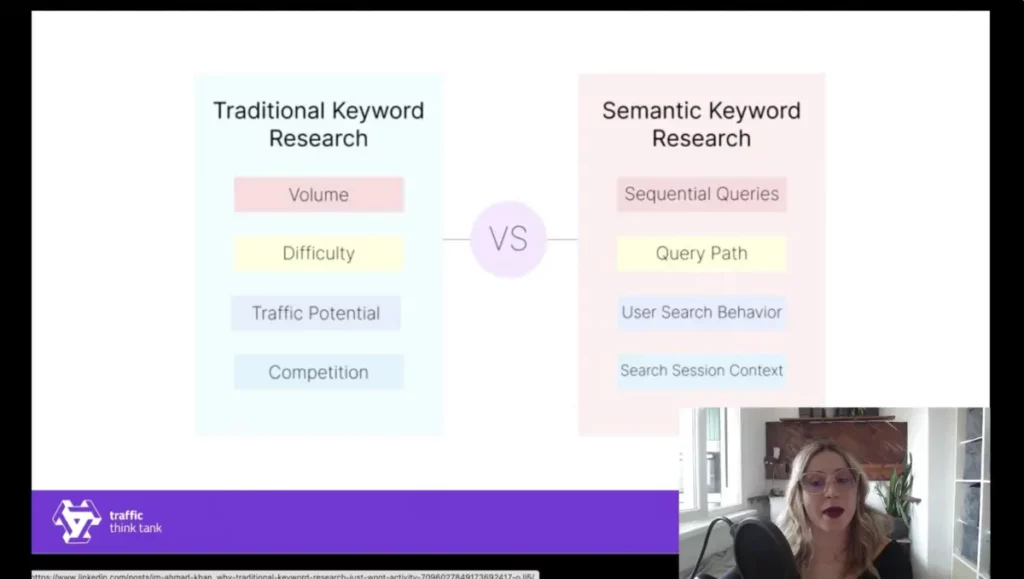
Analyze your competitors’ websites to identify the keywords they are targeting. Look for gaps in their keyword strategy that you can capitalize on with templated landing pages. You can use Semrush’s Website Competitor Analysis Tools tools to help with this process.
When compiling your list of target keywords, consider organizing them into categories or themes. This will help you create a more structured and effective content template for your landing pages.
3. Gather Data
Once you’ve created your target keywords list, the next step is to gather data on the search intent behind those terms. Search intent refers to a user’s primary goal when searching for a specific word or phrase.
Search intent typically falls into four main types: navigational (seeking a specific website), informational (learning about a topic), commercial (researching before a purchase), and transactional (ready to take action or make a purchase).
For programmatic SEO, focus on keywords with transactional or commercial intent. Users who search for these terms are typically closer to the bottom of the marketing funnel and more likely to convert.
How do you figure out the search intent for the keywords you’re considering? I recommend analyzing top-ranking pages for those target keywords. The types of content that appear in the search results can give you a strong indication of the intent behind the query.
For example, if the results are mostly product pages, the intent is likely transactional. If the results are mainly blog posts or informational articles, the intent is probably informational.
Also, look closely at the modifiers used in your target keywords, as they often provide clues about the user’s intent. Keywords containing modifiers like “buy,” “best,” “cheap,” or “review” typically indicate a transactional or commercial intent.
4. Map Out Internal Linking
Internal linking is a crucial aspect of any SEO strategy, and it’s no different when it comes to programmatic SEO. You’ll need to map out your internal linking structure to ensure your automatically generated landing pages are properly connected for users and search engines.
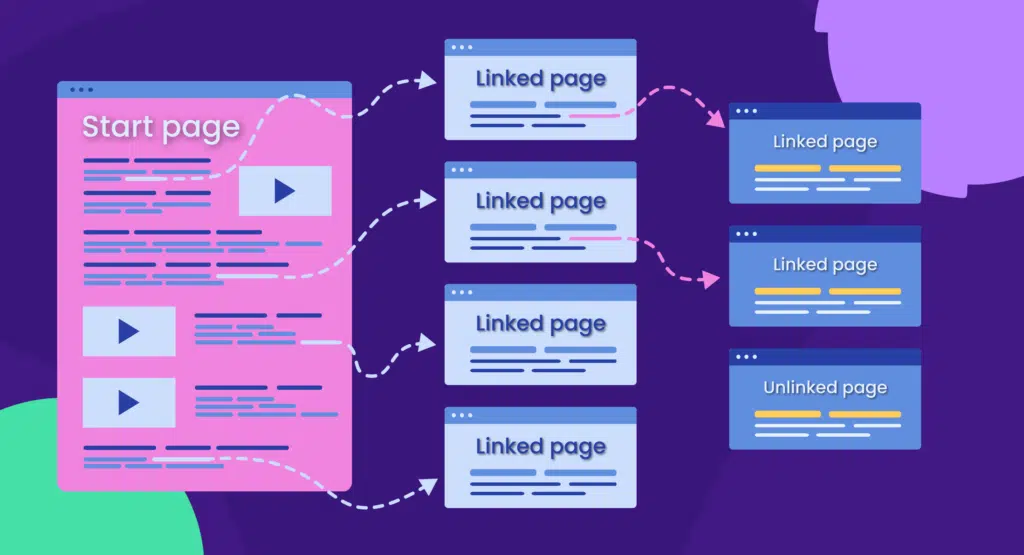
Follow internal linking best practices to map out your structure. This includes using relevant, descriptive anchor text and creating a hierarchical structure that guides users and search engines from your most important pages to your more specific, targeted landing pages.
5. Design an SEO-Friendly Page Template
To efficiently create a large number of landing pages, you need to develop a single webpage template that will serve as the foundation for your programmatic SEO project. This template should be designed with both SEO and UX in mind.
When designing your page template, create a layout that complements your target keywords and your products or services. While each landing page will share the same basic elements, such as graphics, reviews, and lists, the content will vary between pages to avoid potential penalties from Google for duplicate content.
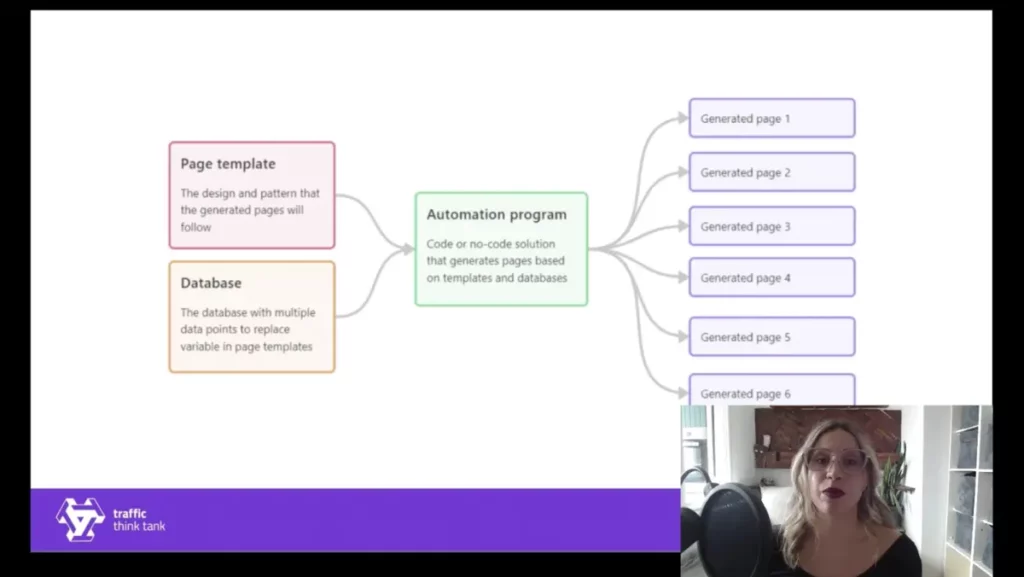
To determine the most effective layout and content elements for your landing pages, analyze the top-ranking pages for your target keywords. Tools like Semrush’s SEO Content Template can help you decide what to include in your template.
Once you understand the content requirements, design your page template with a clean, user-friendly layout that makes it easy for visitors to find the information they need. As always, your pages need to be responsive, so make sure to optimize your template for mobile devices.
6. Create and Fill Pages in Bulk
With your SEO-friendly page template designed and ready, it’s time to generate your landing pages at scale. This is where the power of programmatic SEO truly shines. You’ll be able to create hundreds or thousands of unique pages quickly and efficiently by leveraging automation tools and techniques.
To fill your pages with content in bulk, start by preparing a database or spreadsheet containing all the necessary information for each landing page. Include target keywords, product details, images, and other relevant data.
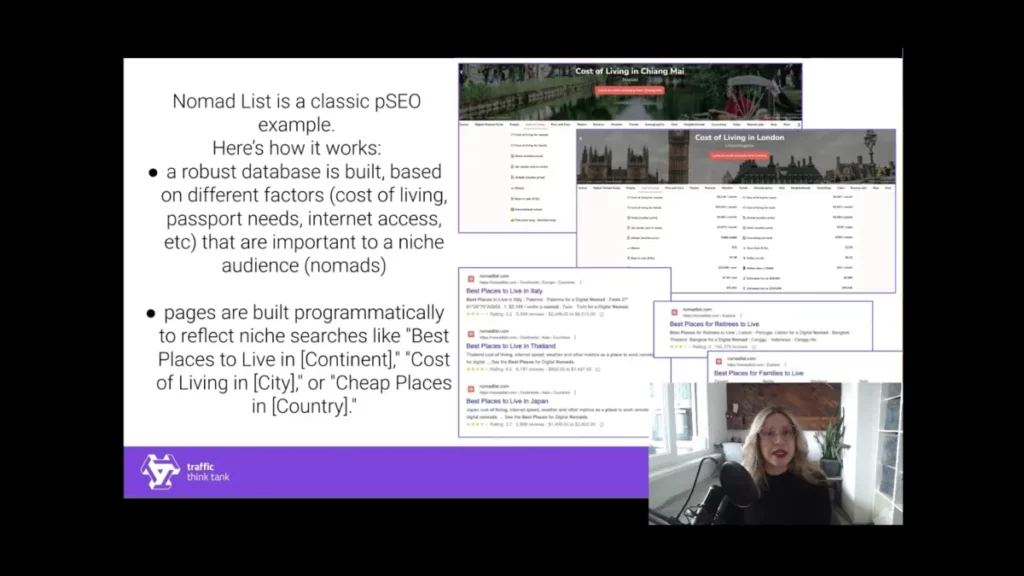
Once your data is organized, useautomation software or scripts (more on programmatic SEO tools below) to populate your page template with the appropriate content for each unique landing page.
This process allows you to create a large number of pages in a fraction of the time it would take to do so manually, while still ensuring that each page provides value for users and is optimized for its specific target keyword.
Essential Programmatic SEO Tools
Programmatic SEO tools are essential for streamlining your efforts and getting great results.
Here are a few go-to choices.
Excel and Google Sheets
Use Excel and Google Spreadsheets to organize and manage the database that will feed your programmatic SEO pages. These spreadsheet applications store and structure significant amounts of data, such as keywords, product information, and content variations, which you’ll use to populate your landing page templates automatically.
Zapier
Zapier is a powerful automation tool that enables you to connect apps and services to automate repetitive tasks in your programmatic SEO workflow. For example, you can use Zapier to automatically transfer data from your spreadsheet database to your page template or to trigger page creation when certain conditions are met.
Semrush
Semrush is a comprehensive SEO and digital marketing tool that can be invaluable for conducting keyword research in your programmatic SEO strategy. With Semrush, you can identify low-competition, long-tail keywords to target with your landing pages, analyze competitor strategies, and gather data on search intent to inform your content creation process.
To learn more, check out our Semrush review.
ChatGPT
ChatGPT can generate unique content variations for your templated landing pages. Provide ChatGPT with your page template, enter relevant data points, and quickly create multiple versions of your content. Each landing page will include unique text optimized for the specific target keyword you want to focus on.
Screaming Frog
Screaming Frog is a website crawling and auditing tool used to gather data and insights for your programmatic SEO strategy. With Screaming Frog, you can crawl your site or competitor sites to analyze their structure, content, and performance. Use the data you gather to identify opportunities for improvement and shape your programmatic SEO approach.
Get Your Programmatic SEO Checklist in TTT Academy
Now that you have a solid understanding of programmatic SEO and its potential to drive growth for your website, the perfect next step is to dive deeper into the topic and learn the nitty-gritty details of implementing this strategy effectively.
The programmatic SEO courses in TTT Academy cover everything you need to know to succeed with this approach, from organizing your database to Zapier tips to template guidelines. Lazarina Stoy even includes a complete programmatic SEO checklist in her course.